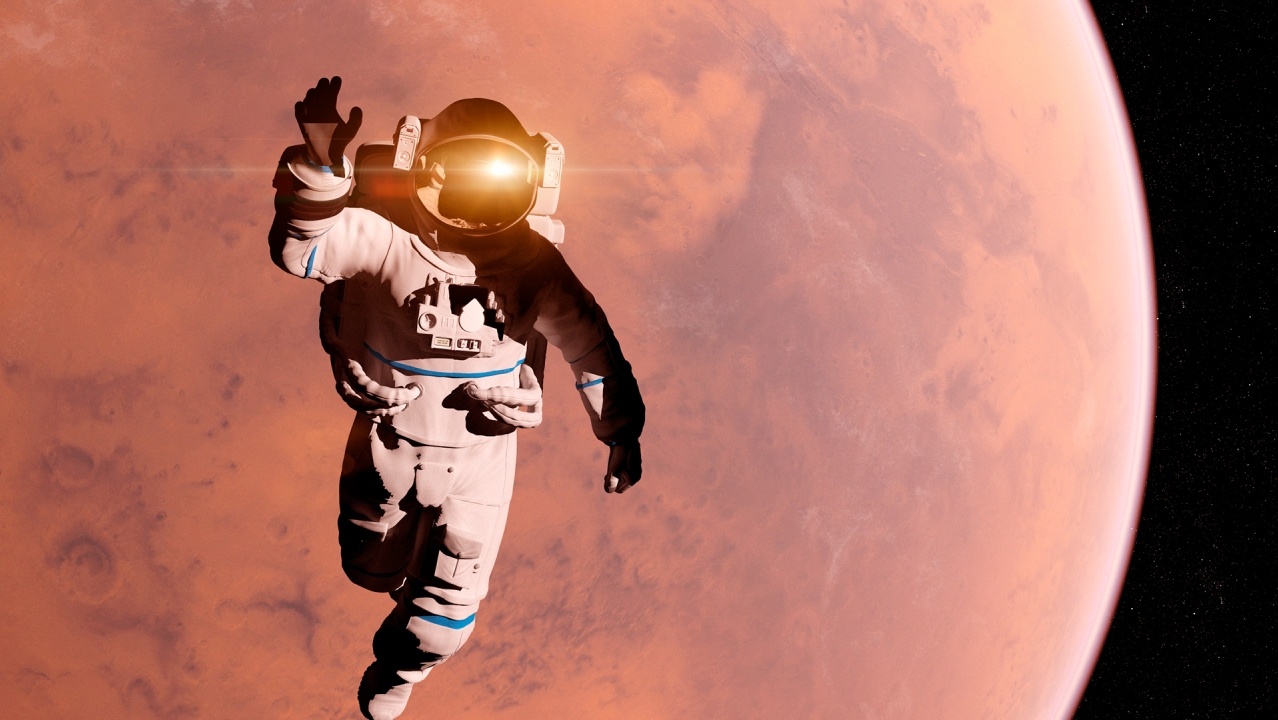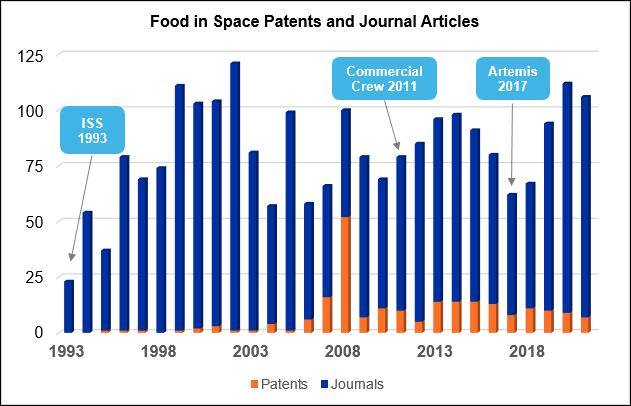Gain new perspectives for faster progress directly to your inbox.

NASA’s Artemis Program is an incredible return back to the moon that may redefine how future humans will eat both in space and on Earth. Seven plant-focused experiments have been approved to understand the different requirements to successfully grow plants in space. In addition to space agriculture, new innovations like 3D printed food, packaging, and novel applications of microbiomes could have major implications for food on Earth. The design challenges of food in space (longevity, closed-loop cycles, nutrition, and inability to cook) can improve access to nutrition in Earth’s challenging environments.
What is needed for food in space?
While most of us on Earth are focused on variety and nutrition in our diets, a few key criteria for space food systems are:
1. Food safety: preventing food spoilage, waste-processing, and recycling with advanced closed-loop ecosystems for plant growth
2. Reliability: has capability to withstand the harsh conditions found in space, a long shelf life, and requires minimal space.
3. Nutrient density and enjoyment (palatable, varied, easily prepared etc.)
Space has unique challenges
Growing plants in space has some challenges due to it being a closed ecosystem with no gravity, no direct sunlight, limited space, and limited water supply. The absence of gravity means cooking is difficult and must minimize the strain of resources on the shuttle (mass, power, crew time, water, waste disposal). Prepackaged foods are not always feasible due to the deterioration of nutrients and enormous quantities required. In the future, deep space exploration will require years of travel with a limited supply of food and water and no possibilities of resupplying.
Publication and patent trends
Publications and patents by NASA and other agencies on space food have been ongoing for decades. Using the CAS Content Collection™, we looked at global scientific publications related to space food and life systems between 2000 and 2022.The research landscape shows that large announcements of new space programs drive an increase in future publications and patents across the globe. For example, the International Space Station has been making a massive effort since it was first announced in 1993.The increase in publications and patents since then is highly correlated to the over 2,500 experiments done since. Similarly, there is a clear trend of increasing research after NASA’s Commercial Crew Program was announced in 2011 and a corresponding bump after the Artemis Program in 2017 (Figure 1).

New solutions: 3D printed space food
Out of this world pizza? Pardon the pun, but new advances in 3D printing food on the International Space Station could have a massive impact on some of the biggest food challenges we have on Earth. 3D printers now produce different designs and customized diets by adding specific ingredients into food. Today Inks for the 3D printer can consist of dried meat, vegetables, and dairy powders, fortified with relevant micronutrients. Some of the most common printable edible inks are mashed potatoes, chocolate, dough, cheese, cream, cake frosting, and fruits.
This technology is crucial for extending the shelf life of space food. It allows the food material to be sterile and stored in raw material form. Additionally, this minimizes storage space on board.
Using microbes to produce nutrients
Researchers are looking into different types of bacteria to convert air components or body waste into nutrients. For example, bacteria — known as hydrogenotrophs (single-celled microorganisms that metabolize hydrogen for energy) — could convert astronauts’ exhaled carbon dioxide into proteins in a fermentation type of process. Other researchers found that Yarrowia lipolytica, a relative of baker's yeast, can be used to make lipids and even plastics by feeding them with human urine opening the possibility of turning natural waste into nutrients essential to human health.
Prepackaged food
While dried or frozen foods are critical, NASA is looking into emerging food preservation technologies for new approaches. For example, the Pressure Assisted Thermal Sterilization and Microwave Sterilization ensures higher initial quality and nutrition in prepackaged food. Researchers are also investigating better packaging to increase food shelf life for up to 5 years.
Closed-loop systems and space farming
The best option for a good and constant source of proper nutrition relies on farming aboard the spaceship. The existence of a space farm would aid the creation of a sustainable environment, as plants can be used to recycle wastewater, generate oxygen, purify the air, and even recycle feces on the spaceship. Currently, there is a space garden, known as Veggie, that is. It can hold six plants and was used to successfully grow lettuce, Chinese cabbage, mizuna mustard, red Russian kale, and zinnia flowers. A list of the plants that were grown in space over the past four decades can be found here.
Real-world implications for space food
Research in this area of space food leads to a better and more sustainable relationship between our food and planet. Closed-loop greenhouses and vertical farming can be utilized in arid, polar, remote, or in highly populated areas due to their low water and land requirements. Producing meat by using air components could reduce livestock and require a lot less land and water usage. An enhanced air purifier created for space food is now currently used for food preservation and in operating rooms.
3D printing of food could play a role in alleviating food shortages here on Earth. 3D printers can be used to create food faster and cleaner than any chef could do, while also customizing nutrition values and textures. The edible inks can also broaden the use of non-traditional sources of food material.
All these technologies can reduce the transport volume, packaging, distribution, and other costs by moving closer to the customers, hence decreasing ecological footprint. The benefits of continued research on space exploration thus extend to Earth’s environment and its inhabitants providing ideas on maintaining and preserving terrestrial ecosystems.



